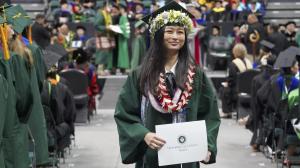contact:

Links to video and sound (details below): https://spaces.hightail.com/receive/gJkcegINVN
In 2031, 70% of all jobs in Hawaii will require more than a high school education, and 36% will require at least a bachelor's degree, according to a new report from Georgetown University. After all: Forecasting employment, education and training requirements to 2031. According to Hawaii P-20 Education Partnership Executive Director Stephen Schatz, the report shows that postsecondary education plays an important role in preparing the future workforce.
“I think there's a misconception here in Hawaii that there are great jobs that you can get straight out of high school with just a high school diploma, but that's not actually the case,” Schatz said. “We find that we need some kind of training, whether it's an apprenticeship program or a community college degree or a four-year degree, we need some kind of training and education beyond high school. ” Our kids get local jobs. ”
Nationally in 2021, approximately 68% of all occupations required at least some postsecondary education. The report predicts that by 2031, 72% of jobs will require postsecondary education or training, and 42% of all jobs will require at least a bachelor's degree.
“We have seen waves like this in the past, but the growing doubts about the value of a university degree are alarming. “We're creating a generation of young people who think they don't need college,” said Anthony P., director of Georgetown University's Center on Education and the Workforce and lead author. . Carnevale said. “However, our findings demonstrate once again that post-secondary education and training have become a baseline requirement for accessing middle-class status and income. It's not the preferred path to. It's becoming the only path.”
According to the report, employment in Hawaii will increase from 591,000 in 2021 to 624,000 in 2031, driven by new jobs and jobs filled for other reasons (most commonly retirements). An average of 72,000 job openings are expected per year. Of the 72,000 job openings annually, 51,000 are for workers with a high school diploma or higher, 18,000 are for workers with a high school diploma, and 3,000 are for workers with less than a high school diploma. It is aimed at
“As jobs become more competitive, the types of skill sets required will become broader and broader, and people will become more prepared,” said Shelley Menor McNamara, president and CEO of the Hawaii Chamber of Commerce. “We will need an educated workforce.” “While some high school graduates go directly into the workforce, it is also important that students explore university opportunities and have exposure to not only the curriculum but what universities have to offer.”
Linking education and employee training
At the University of Hawaii, many initiatives are underway to prepare Hawaii's future workforce. The Hawaii P-20 Council, a group of education, business, and community leaders, is working to ensure that all stakeholders work together to align the education pipeline with the needs of the workforce. We launched “Hawaii Alumni for Hawaii's Future.”
The University Strategic Plan 2023-2029 prioritizes developing successful students for a better future, meeting Hawaii's workforce needs, and diversifying Hawaii's economy through university innovation and research.
“As the only provider of higher education in the state, the 10-campus UH system and UH’s support will be key in preparing the workforce of the future,” Schatz said. “It starts with recognizing the value of post-secondary education, not only for the collective benefit of our nation, but also for the benefits that higher education provides individuals who are by far the best way to increase economic mobility.” It’s also about impact.”
Make your UH degree affordable and have a significant return on investment.
Researchers at the University of California Economic Research Organization (UHERO) found that those with a bachelor's degree had lifetime earnings of $2.8 million, 27% higher than those without a degree, and those with an Associate of Science (AS) or Associate of Applied Science degree. (AAS) degree holders, it was found to be $2.7 million. , 22% higher than those without a degree.
UHERO also notes that while college tuition has increased significantly nationally over the past 20 years, tuition within the UH system has become more affordable over the past 10 years, even when adjusted for inflation. I also discovered that.
see this university news Read the story to learn more about the UHERO report.
Links to video and sound (details below): https://spaces.hightail.com/receive/gJkcegINVN
video:
Brawl: (1:46)
0:00-1:46 – UH System
Soundbites:
Steven Schatz, Hawaii P-20 Executive Director
(0:16)
“We find that there needs to be some training, whether it's an apprenticeship program, whether it's a community college degree, whether it's a four-year degree. We need some kind of training and education beyond high school.” Our children get local jobs. ”
Sherry Menor McNamara, Hawaii Chamber of Commerce President and CEO
(0:12)
“As competition for jobs increases, the types of skill sets required will become broader and broader, requiring a better prepared and educated workforce.”


